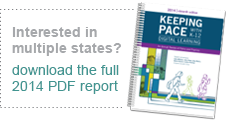Data & Information
Utah
Utah has a state virtual school (the Utah Electronic High School), four statewide fully online charter schools, and many districts offering online courses via the Statewide Online Education Program (SOEP), which is among the first and best-known course choice programs in the country. Although course choice in Utah has received extensive attention, it is still quite small (though growing), serving 3,208 course enrollments (or 6,416 quarter credits) in SY 2013-14. This is an increase of 151% from the previous year.Fully online schools
Four statewide online charter schools served 3,491 students in SY 2013-14, a 14% annual increase. Utah Virtual Academy served 1,956 K-12 students in SY 2013-14, a 5% annual decrease. Mountain Heights Academy, formally the Open High School of Utah, enrolled 389 students in SY 2013-14, a 16% annual increase. (Mountain Heights is the only school in the country whose course materials are based entirely on open educational resources.) Utah Connections Academy reported 689 enrollments, a 53% increase, and Alianza Academy reported 457 enrollments in SY 2013-14, a decrease of 9%.
State virtual school
The Utah Electronic High School (EHS) is primarily a supplemental program that works with local school districts, but is able to grant diplomas to restricted groups of Utah students: those who are homeschooled exclusively, those who have dropped out of school and their class has graduated, and district referrals. All of the courses are open-entry/open-exit. EHS started in 1994 as a statewide virtual school located at the Utah State Office of Education (USOE) which funded it via USOE funds. Legislation passed in 2001 started line-item funding. This annual line item funding was $2 million each year from 2007 through 2012 and $1 million for SY 2012-13. EHS does not receive per-pupil state funding allocations with resident school districts. EHS will continue to offer courses in 2011; the SB65 Education Interim Committee will make recommendations to the 2012 legislature as to the future role and funding of EHS. During SY 2013-14, EHS granted 9,482 quarter credits to 4,817 individual students (the equivalent of 4,741 individual semester course completions), a 54% decrease from the previous year. EHS implemented proctored final tests for every quarter credit granted beginning October 2007. EHS launched an open source content initiative in 2010 called the Utah Electronic High School Curriculum and is rolling it out gradually via iTunesU.
District programs
Multiple Utah districts are offering online programs or creating online schools to provide services to students across the state for a per course fee set at the state level. Some online schools or programs are contracting with vendors such as APEX, K12 Inc., or Education2020 for curriculum and services, while others are creating their own curriculum. A full list of district programs is available at: http://www.schools.utah.gov/edonline/Students-and-Parents.aspx.
Brigham Young University (BYU) runs the BYU Independent Study program that is accredited by the Northwest Association of Accredited Schools (NAAS) and the Distance Education and Training Council (DETC). It allows credits earned through BYU Independent Study to transfer to other educational institutions outside of Utah that share NAAS accreditation. As of September 2012 the National Collegiate Athletic Association (NCAA) accepts online credits from some of BYU’s high school courses.
Online learning policy history
2011: SB65, the Statewide Online Education Program, was signed into law on March 30, 2011, and went into effect on July 1, 2011, making Utah the first state in the nation to turn the Digital Learning Now Ten Elements of High Quality Digital Learning into a comprehensive state policy. The ten elements served as the roadmap for creating the state’s online learning policy, including the following elements:
- Students can supplement their brick-and-mortar education with online courses.
– Students / parents choose the courses and course providers; the student’s primary school of enrollment does not have control. Course selection is tied to the counselor-led Student Education Occupation Plan (SEOP), and must be aligned to graduation requirements.
– Subject mastery replaces seat time, which allows students to advance based on competency.
– Homeschool and private students will be eligible for the Statewide Online Education Program in year three.
- Funding follows the student down to the course level; from “Primary Local Education Agency (LEA) of enrollment” to “Provider LEA.”
– Funding is based upon successful completion; the provider receives 50% (25% per semester) up front and the remaining 50% upon credit earned.
– Providers are incented to offer credit recovery courses, as they can receive 30% of the final 50% funding payment outside of the designated timeline for completion if the student earns the course credit prior to graduation.
- Multiple providers are being authorized.
– The State Board of Education shall develop a report on the performance of online course providers.
– Course providers may not limit the class size of an online course.
– Open-entry, open-exit online courses are permitted if offered by the provider.
– Each provider administers state assessments; the state is required to make assessments available upon course completion.
– Any LEA—charter or district—can be an online provider.
– Any LEA can contract with private providers to offer an online program.
– Any online course provider can apply to offer courses directly to students starting with the 2012-13 school year.
- All LEAs must distribute information about online programs during registration, and publish information on their website.
- The bill provides $250,000 for the administration of the program for the 2011-12 school year.
last updated September 29, 2014
back to map


